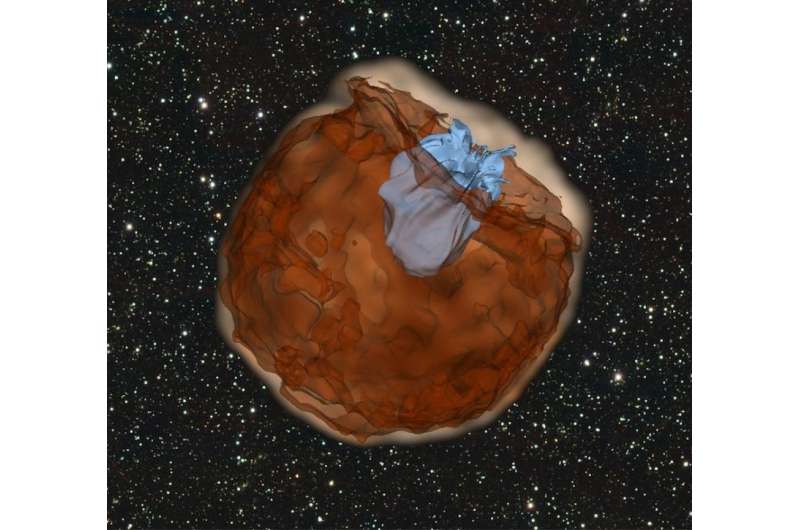Mystery of exploding stars yields to astrophysicists

A longstanding mystery about the tiny stars that let loose powerful explosions known as Type Ia supernovae might finally be solved.
For decades, astronomers have debated whether one white dwarf star, or two, is necessary for firing up this particular kind of supernova. The answer is not merely academic. Understanding the nitty-gritty physics and diversity of Type Ia supernovae will help illuminate our study of the evolution of galaxies and the strange cosmic force known as dark energy.
"It's about understanding one of the ultimate mysteries about stars," Laura Chomiuk, an Assistant Professor in Michigan State University's Department of Physics and Astronomy, told The Kavli Foundation in a roundtable discussion. "Something in the universe makes one percent of white dwarfs commit suicide and explode as supernovae. We are only now starting to have an idea of what causes this."
Chomiuk was one of four astrophysicist who came together to discuss the importance of two studies, published earlier this year in the journal Nature, that offer some of the strongest evidence to date that either one or two white dwarfs can trigger Type Ia supernovae.
"Previously, we all thought there was just going to be one scenario for Type Ia supernovae," said Andrew Howell, a Staff Scientist at Las Cumbres Observatory Global Telescope Network (LCOGT), an adjunct faculty member in the Physics Department at the University of California, Santa Barbara (UCSB), and an author of several recent papers. "But now we're starting to see that there are many different ways to make a Type Ia supernova."
The Nature studies relied on a new theory proposed by physicist Daniel Kasen. He predicted that the material hurled out from an exploding white dwarf "corpse" star should create an observable ultraviolet flash when it slams into a nearby, normal companion star. That companion star is a necessary ingredient in the single white dwarf scenario, as it provides the matter that triggers the white dwarf's thermonuclear explosion. An alternative scenario calls for two dwarfs to merge and blow up.
Observational astronomers, such as Howell, have recently seen Type 1a supernovae with and without the telltale ultraviolet flash predicted by Kasen.
"People have discussed over the years whether companion stars could survive the blast from a nearby supernova explosion. But nobody had asked, 'What would it look like to actually see that happen?'" said Kasen, an Associate Professor of Astronomy and Physics at the University of California, Berkeley, a faculty scientist at the Lawrence Berkeley National Laboratory, and a coauthor of one of the Nature papers. "So I did a back-of-the-envelope calculation to estimate how hot that collision would be, how bright it might be, and so on. Surprisingly, the collision turned out to be bright enough to be seen on Earth. That gave the observers an idea of what to look for."
These discoveries have come about in large part thanks to new telescope survey projects, using a suite of instruments available in space and on the ground, and advances in computer modeling that strengthen theoretical models.
"It's not just new capabilities but all these new capabilities working together that are allowing us to make such progress," said Lars Bildsten, the Director of the Kavli Institute for Theoretical Physics (KITP) and a Professor in the Physics Department at the University of California, Santa Barbara.
A more thorough knowledge of Type Ia supernovae will inform many areas of astrophysics and cosmology. For instance, the energy unleashed by supernovae can modify galaxies by dispersing the matter required by new stars to form.
Type Ia supernovae also explode with an intrinsic brightness, which scientists have long relied on to calculate cosmic distances. Such distance measurements are integral for tracking the acceleration of the expansion of the universe due to dark energy.
Amazingly, Type Ia supernova can outshine entire galaxies of billions of stars, making them easy to spot across cosmic history. Getting the mechanics right of these explosions will further explain how the deaths of certain stars make for such impressive stellar pyrotechnics.
More information: No signature of ejecta interaction with a stellar companion in three type Ia supernovae, Nature 521, 332–335 (21 May 2015) DOI: 10.1038/nature14455
A strong ultraviolet pulse from a newborn type Ia supernova, Nature 521, 328–331 (21 May 2015) DOI: 10.1038/nature14440
Journal information: Nature
Provided by The Kavli Foundation





















